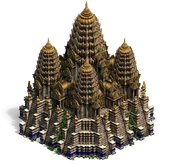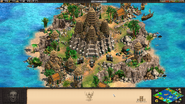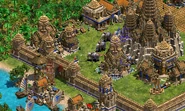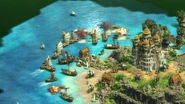The Khmer are a Southeast Asian civilization introduced in Age of Empires II HD: Rise of the Rajas. They focus on siege weapons and elephant units, in their case Battle Elephants and Ballista Elephants.
The capital of the Khmer Empire was Angkor, which is one of the largest pre-industrial cities. At its peak, the city supported one million people. This is reflected by two of their bonuses: Villagers can garrison inside Houses, and they do not need to build certain buildings to unlock other buildings or to advance to the next Ages. Like their Persian and Indian neighbors to the west, the Khmer Empire was known to employ war elephants widely for both tactical and logistical purpose. To reflect this, their Battle Elephants move faster and can be upgraded to deal more damage with the Tusk Swords unique technology.
Like their Chinese neighbor to the north, the Khmer Empire was also known to employ ballista technology. Consequently, their team bonus increases the range of Scorpions. In addition, Khmer also possess a ballista-carrying unique unit named Ballista Elephant. Furthermore, the number of missiles fired by both Ballista Elephants and Scorpions can be increased with the Double Crossbow unique technology.
Overview
The Khmer are classified as an elephant and siege civilization, and they really shine in their advertised departments. Their Battle Elephants are particularly dangerous as they get a notable speed boost which, along with Husbandry, effectively addresses their greatest weakness which is the low speed (although they are still not fast enough to escape Halberdiers). Additionally, they get +3 attack out of Tusk Swords which lifts their attack to levels only the Elite War Elephant sits in. Their cavalry department in general is fairly usable, too, but key traits such as the Paladin and Hussar are missing, which is why the Battle Elephant is usually the cavalry unit of choice. The infantry is rather weak without Champions, Squires, and Plate Mail Armor. Their archers are average even without Thumb Ring, although their Cavalry Archers get Parthian Tactics. The Khmer siege weapons are excellent for one reason: their Scorpions. They get +1 range from their team bonus and another +1 from Siege Engineers for a total of 9 - enough to outrange Arbalests, and they get a second bolt fired simultaneously (from Double Crossbow) which greatly increases their damage output. The Ballista Elephant also deserves a mention here as it broadens the versatility in their siege department, but it often struggles to be effective unless used in mass numbers. Their navy is also very good, only lacking the Heavy Demolition Ship, but their Monks leave much to be desired. Their defensive structures are average, and their economy is lacking as well without Two-Man Saw and Guilds.
Characteristics
Unique unit
 Ballista Elephant: Heavy cavalry siege unit
Ballista Elephant: Heavy cavalry siege unit
Unique technologies
 Tusk Swords: Gives Battle Elephants +3 attack.
Tusk Swords: Gives Battle Elephants +3 attack. Double Crossbow: Gives Ballista Elephants and Scorpions a second bolt.
Double Crossbow: Gives Ballista Elephants and Scorpions a second bolt.
Civilization bonuses
- No buildings are required to construct certain buildings or advance in Age.
- Battle Elephants move +15% faster.
- Villagers can garrison in Houses.
Team bonus
- Scorpions have +1 range.
Changelog
Rise of the Rajas
- Initially cannot train Arbalests. With patch 5.8, they were added to the technology tree.
In-game dialogue language
In-game, Khmer units speak Khmer, the official language of modern Cambodia. An Austroasiatic language (related to the Vietnamese one), it is one of the few major languages of mainland Southeast Asia that is non-tonal (along with Malay). It shares similarities with Malay due to Indian and Sanskrit influence, e.g. Suosdey (Khmer) and Swasti (Malay).
- Villagers
- Chah ចា៎ស់ (female) - Yes
- Bat បាទ (male) - Yes
- Tae neak mean lomdab? តើអ្នកមានលំដប់? - Do you have order?
- Mean kar banhcheatinh? មានការបានជាទន? - Have orders?
- Peak ban chea? ពក់បានជា? - Command?
- Aroun suosdey អរុណសួរស្ដី - Good morning
- Kniom neung teuw ti nouh ខ្ញុំនឹងទៅទីនេាះ - I will go there
- Ban yol បានយល់ - Understood
- Troemotrauv ត្រូវមក់ត្រូវ- All right
- Neung chuosachoul - Will repair
- Neung bramoul នឹងប្រមូល - Will gather
- Neung pongrong - Will cultivate
- Neung kab chheu នឹងកាប់ឈេី - Will chop down wood
- Neung chik dom th - Will dig stones
- Neung sangsang នឹងសង់ៗ - Will construct
- Military
- Bat បាទ - Yes
- Peak banh chea ពក់បានជា? - Command?
- Bamnng robsa neak? - Your wish?
- Kniom neung teuw ខ្ញុំនឹងទៅ - I will go
- Kniom yol ខ្ញុំយល់ - I understand
- Teuw moukh! ទៅមុខ! - Forward!
AI player names
When playing a random map game against the computer, the player may encounter any of the following Khmer AI characters:
- Barom Reachea I (បរមរាមាធិបតី, also known as Dhamkat (ដំខាត់); reigned 1363 to 1370): One of the last kings of the Khmer Empire under the rule of the Thai Kingdom of Ayutthaya. He lead a rebellion against the Ayutthaya Empire before he died after being poisoned by his crucibles, leading to civil war and downfall of Khmer Empire. Father of Ponhea Yat.
- Indravarman III (ឥន្ទ្រវរ្ម័នទី៣; reigned 1295 to 1308): King of the Khmer Empire, also titled Srindravarman (Khmer: ស្រីន្ទ្រវរ្ម័ន). Upon his ascent to power, he declared Theravada Buddhism as the state religion. Son-in-law of Jayavarman VIII.
- Jayavarman II (ជ័យវរ្ម័នទី២; reigned 802 to 835): Founder of the Khmer Empire, he unified several parts of Khmer warlord states, marking the beginning of Angkor (great city) era in Cambodia history.
- Jayavarman VII Mahaparamasaugata (ជ័យវរ្ម័នទី៧; 1125-1218, reigned 1181 to 1218): Regarded as one of the greatest kings in Khmer history and his reign is remembered as the "golden age" of the Khmer Empire. During his reign, he defeated the Champas, expanding his empire to its greatest extent, as well as building the Bayon Temple and hundreds of Buddhist temples.
- Jayaviravarman (reigned 1002 to 1006): Khmer King who dethroned Udayadityavarman I, ruled the Khmer Empire during the civil war before being defeated by Suryavarman I.
- Ponhea Yat (ពញាយ៉ាត; 1396-1463, reigned 1405 - 1463): The last king of the Khmer Empire who reigned at the age of 11, known by his reigning title as Barom Reachea II (បរមរាជាទី២). After the attack by the Ayutthaya Kingdom in 1436, he was forced to submit his kingdom to the Ayutthaya, ending the Angkor era and beginning the era of the Kingdom of Cambodia, which saw the conquest over Cambodia between the Siamese and the Vietnamese.
- Rajendravarman II (ជេន្ទ្រវរ្ម័នទី២; reigned 944 to 968): King of the Khmer Empire, described as a great warrior-king who ruled his people kindly.
- Sangrama (died in 1065): General under the service of Udayadityavarman II, he was credited for putting down several rebellions against Udayadityavarman II's rule.
- Suryavarman I (សូរ្យវរ្ម័នទី១; reigned 1006 to 1050): First king of the united Khmer Empire. During his reign, he expanded his territory to the west to Lopburi, including the Menam basin in Thailand, and east into the Mekong basin. After his death in 1050, he gained the posthumous title Nirvanapada (the king who has gone to nirvana) for his Buddhist beliefs.
- Suryavarman II Paramavishnuloka (សូរ្យវរ្ម័នទី២; reigned 1113 to 1145/1150): King of the Khmer Empire, widely regarded as the greatest king of Khmer Empire, well known for building the Angkor Wat, the largest religious monument in the world.
- Udayadityavarman I (reigned for only few months in 1002): Succeeded the throne after Jayavarman V, Udayadityavarman I later dethroned by Jayaviravarman in 1002.
- Yasovarman I (ព្រះបាទយសោវរ្ម័នទី១; reigned 889 - 910): King of the Khmer Empire. His reign is remarkable for various major construction projects, he built several water reservoirs around the new capital of Yasodharapura (later known as Angkor) as well as a hundred monasteries.
Trivia
- Despite the Khmer civilization depicted in Rise of Rajas are based on the Khmer Empire, their depiction in early version of campaign's cutscene erroneously depicting various Khmers (including Suryavarman I) to wearing Siamese (Thai) warrior costumes. this were later fixed in later version.
- However, Suryavarman I depicted in expansion's cover and various Khmer hero unit in-game icons is still depicted as wearing Siamese clothes.
- If a player picks the Khmer civilization, the bottom left and middle of the navigation bar will show the image of a human face and human-bird creature respectively. The face is based from the statues found in Bayon Temple depicting the face of Avalokitesvara, the Bodhisattva of compassion. The human-bird creature is known as Garuda, a mythical creature in Hindu mythology who served as a transport for Hindu god, Krishna. commonly depicted in Angkor reliefs as symbol of power.
- The Garuda also shows similarities to the modern national emblem and monarchy symbol of Thailand.
- Khmer Houses can be compared to Atlantean Manors from Age of Mythology: The Titans; both can garrison Villagers. However, Manors support more population, soldiers can garrison inside and also cost some gold alongside wood.
- They are the only civilization outside most Age of Empires III civilizations (Asian ones, however, need to construct Wonders) that can advance to the next Age without requirements.
- Although Khmer are one of the newest civilizations in Age of Empires II series, they have long been considered as the new potential addition by Ensemble Studio. During the development of The Conquerors expansion, Khmer - along with Tibetans and Koreans - were considered as one of the new factions to represent Far East region. Eventually, the developers picked Koreans because they were impressed with Turtle Ships and attracted by potential sales in South Korea.[1]
- Khmer Battle Elephants are the weakest against conversion, because they have no access to Faith.







